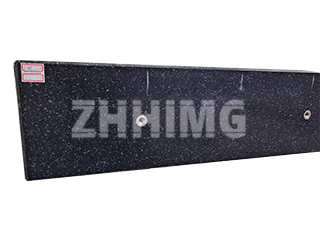The Evolution of the Precision Reference
In the world of industrial metrology and machining, the granite testing platform has become the gold standard for defining a perfect reference plane. While older, simpler techniques like the dye penetrant method (or coloring method) have their place in quick surface inspection, they pale in comparison to the fundamental advantages and enduring reliability offered by granite.
At ZHHIMG®, we manufacture these platforms from high-quality igneous rock, primarily composed of quartz and feldspar. This material has undergone millions of years of natural aging, ensuring a uniformly dense structure, high strength, and unparalleled stability. This geological pedigree allows our platforms to maintain high accuracy under heavy loads—something no quick surface inspection method can guarantee.
Granite vs. Coloring: A Comparison of Fundamentals
The coloring method is excellent for visualizing gaps and contact points on a surface. However, it is an indirect, subjective visual technique. The granite platform, in contrast, serves as an absolute, objective reference tool, offering critical mechanical advantages:
- Dimensional Integrity is King: The high hardness of ZHHIMG® granite (equivalent to HRC > 51) is two to three times that of cast iron. This ensures superior precision retention. Where a heavy impact might plastically deform a metal reference plate, granite will, at most, harmlessly chip a few fragments, leaving the core dimensional accuracy intact. This is the difference between a temporary dye indicator and a lasting, stable reference.
- No Compromise on Material Science: As a non-metallic material, granite eliminates magnetic reaction and plastic deformation. It boasts comprehensive advantages: it is rust-resistant, acid and alkali-resistant, and non-magnetized. These properties guarantee that the reference surface itself will not introduce errors or require complex rust maintenance, which is impossible to achieve with a mere surface inspection method.
- Stability Across the Board: Granite’s fine, uniform structure ensures consistency. This fundamental stability allows our platforms to be used in conjunction with advanced techniques like the optical gap method—a verification approach far more accurate and flexible than traditional indicators.2 While the dye method is limited to surface geometry, granite enables a host of accurate, comparative, and spatial measurements.
The True Cost of Precision: Manufacturing and Use
The manufacturing process for ZHHIMG® granite platforms, which involves careful cutting, shaping, and precise grinding within constant-temperature chambers, demands far higher precision standards than those for cast iron. This meticulous process ensures the platform can support projects with the tightest requirements.
Despite this intensive manufacturing process, granite testing platforms are simpler to use, easier to maintain, and lower in overall long-term cost compared to constantly recalibrating complex measuring instruments. By using the granite platform with standard measuring components (like gauge blocks), manufacturers can perform reliable comparative measurements, ensuring a certified level of measurement accuracy.
While the coloring method offers a quick visual confirmation, only a precision granite platform offers the stable, non-deforming, non-magnetic, and chemically inert foundation required for true, verifiable high-precision work in both the laboratory and the demanding industrial environment.
Post time: Nov-12-2025

